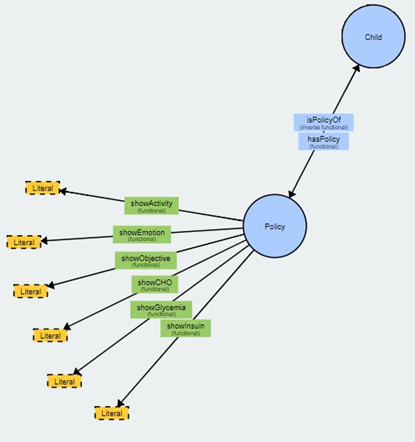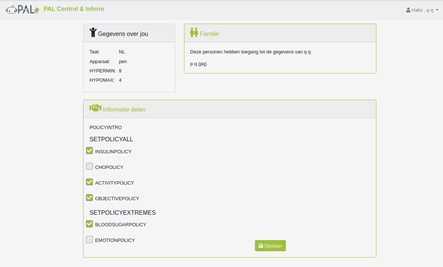Agreement
OWL file
The agreement ontology can be found in the domain ontology (link)
Authors
Willeke van Vught
Short description of ontology
This ontology enables a user to make agreements about what information is shared amongst others and what information is not. It is inspired by the Kayal (2017) and by the paper of Mioch, Peeters and Neerincx (2018) .
Combining the work of Kayal (2017) and Mioch, Peeters and Neerincx (2018) we can conclude that a policy/agreement is built as follows: there is an antecedent that is triggered by a condition (e.g. the deptor is at a location within a certain time frame). If there is an agreement/policy that is triggerd by this condition, the consequent will happen (e.g. the deptor has to share/notshare information with a creditor).
In PAL, this idea of policies/agreements is implemented. However, in PAL we only gather information about the deptor via interaction with the PAL system and therefore our policies are limited in their variety. Furthermore, it is only possible to share information with the parents of the child and the HCP because PAL only includes interfaces for that team of people. Because of that, we implemented a simplified version of the polices.
The implementation of the policies in PAL is as follows: the deptor is always the child and the creditor are always the parents and the HCP. The antecedent is inserting data in the PAL system, this is one off; insulin data, carbohydrates data, activity data, objectives data, blood sugar data and emotional data. Lastly, the consequent is always sharing or not sharing this data. This consequent is based on the settings of the policies and is the only variable that can be manipulated by the users.
Related work
Mioch, T., Peeters, M. M., & Nccrincx, M. A. (2018, August). Improving Adaptive Human-Robot Cooperation through Work Agreements. In 2018 27th IEEE International Symposium on Robot and Human Interactive Communication (RO-MAN) (pp. 1105-1110). IEEE.
Kayal, A. (2017). Normative Social Applications: User-centered Models for Sharing Location in the Family Life Domain.
Ontology design
Ontology development
Based on user experiments with the parents of children with diabetes, we evaluated what kind of data they (the users) found relative to share in this context. Besides that, we did a user experiment with the children to evaluate if they would like to share this data or not, and why. Based on these experiments and on the data we could collect with the PAL system, we selected the topics of the policies.
In essence, PAL is prohibited to share information with parents and HCP unless specified otherwise in other policies. If the Child approves sharing information, PAL is obligated to inform the creditor about that content. However, because the gathered information is linked to the medical condition of children, we want to facilitate the balance between privacy and safety. Therefore, we implemented rules that data about threatening medical conditions (e.g. high/low blood glucose or a long-lasting negative emotional feeling) will always be communicated to the parent and HCP, regarding the setting of the policies.
Ontology structure
As explained in the ‘short description’ the only variable that can be manipulated by the user is the consequent of sharing or not sharing. Therefore, the implementation of the ontology can be very simplified, namely; a child has a policy which has a data property for each agreement. This property can be ‘True’, which means data will be shared, or ‘False’. For non-medical related data, ‘False’ means that data will not be shared with the creditor. For medical-related data (blood glucose or emotional feelings) ‘False’means that in principle data will not be shared, unless it might be a threat to the medical health of the child, in which case it will be shared with the creditors. A visualization of the ontology can be found in Figure 1.

Figure 1: the visual representation of the policy ontology.
Evaluation and results
The policies are implemented in the PAL system and evaluated by the end users. When starting with the experiment, the experimenters explained that data can be shared and to ensure privacy, children and parents can select which information they want to share and which not. The child was the ‘owner’ of these settings, however, they were explicitly told that they should set these settings together with their parents to ensure that both parties are aware and satisfied with the policies on information sharing. Besides that, they got a login so that they could adapt the policy settings at home at any moment in time. A screenshot of the dashboard to set the policies is shown in Figure 2.
The implementation of the ontology worked well. It was very easy to make the agreements and because there was only one variable that could be set, it was easy to understand for the children. The dashboard that showed the information was not used by the participants, which caused it not possible to evaluate the policies with the end users based on the usage. However, in the discussions about this topic, they did indicate that it is important to make such agreements and that they have to be adaptable over time because the need for information might change over time. Exactly this functionality was facilitated by the currently implemented ontology.

Figure 2: a screenshot of policy setting screen
